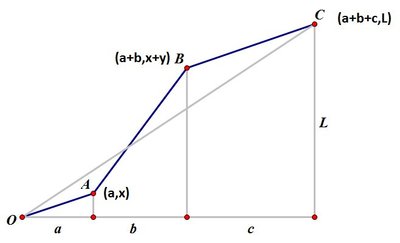An algebra problem by I Gede Arya Raditya Parameswara
Let x , y , z be all real numbers such that x + y + z = 2 .
What is the minimum value of n = x 2 + 7 + y 2 + 1 1 + z 2 + 1 3 ?
Give your answer to 3 decimal places.
The answer is 9.774.
This section requires Javascript.
You are seeing this because something didn't load right. We suggest you, (a) try
refreshing the page, (b) enabling javascript if it is disabled on your browser and,
finally, (c)
loading the
non-javascript version of this page
. We're sorry about the hassle.
2 solutions
Good solution
it is clear that n has no maximum value, but does have a minimum value.
But why can't it be an inflection point? Is it because "you have shown that it has no maximum value, and the constraint domain has no boundaries, then it follows that whatever extremal value (single, not plural) that you've found must be a minimum value" ?
On the other hand, looking at the type of problems the author has posted, I'm pretty confident that this problem should be solved using some classical inequalities method. Maybe Cauchy-Schwarz inequality ? I'll be back on my drawing board...
Log in to reply
Since the function is positive, it must have an infimum. Since n is a continuous function of x , y , z which tends to infinity as ∥ ( x , y , z ) ∥ → ∞ , we can restrict attention to a compact subdomain to see that the infimum must be a minimum. There is nothing stopping there being a saddle-point (the multi-dimensional version of an inflection), but the method of LM only finds one extremum. Since there is a minimum, that must be it, and there are no saddle-points.
Is there any way without using Lagrange's Multiplier ??
Log in to reply
What is the shortest distance from O to C ? Obviously ( a + b + c ) 2 + L 2 .

What is the distance from O to C if we go by straight line segments via A and B as shown (so that O , A , B , C have fixed x -coordinates and steadily increasing y -coordinate)? Obviously x 2 + a 2 + y 2 + b 2 + z 2 + c 2 where x , y , z ≥ 0 and x + y + z = L . Thus the minimum value of x 2 + a 2 + y 2 + b 2 + z 2 + c 2 subject to the restrictions x , y , z ≥ 0 x + y + z = L is ( a + b + c ) 2 + L 2 if we choose A , B to lie on the line segment O C . Now put a = 7 , b = 1 1 , c = 1 3 , L = 2 .
Clue: Pythagoras theorem
If you want a full solution, I don't mind doing it.
Let a = x i + 7 j
b = y i + 1 1 j
c = z i + 1 3 j
Now we know
∣ a + b + c ∣ ≤ ∣ a ∣ + ∣ b ∣ + ∣ c ∣
Thus answer follows.
Appling the method of Lagrange multipliers, we need to solve the equations x 2 + 7 x = y 2 + 1 1 y = z 2 + 1 3 z x + y + z = 2 and these equations have the unique solution x = 7 + 1 1 + 1 3 2 7 y = 7 + 1 1 + 1 3 2 1 1 z = 7 + 1 1 + 1 3 2 1 3 at which point n = 3 5 + 2 7 7 + 2 9 1 + 2 1 4 3 = 9 . 7 7 4 7 2 Since n is a positive function which diverges to infinity as any of x , y , z tends to ∞ , it is clear that n has no maximum value, but does have a minimum value. Moreover, the constraint domain x + y + z = 2 has no boundaries, and hence the minimum point will be identified by the method of Lagrange multipliers. Since the LM method produces just one extremum, it must be the desired minimum.